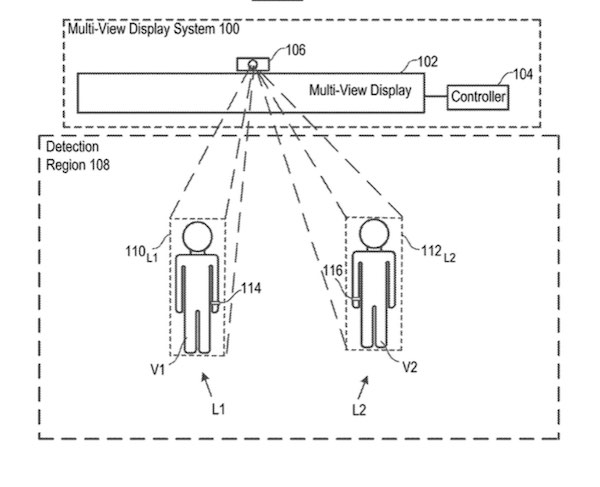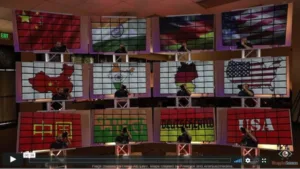If you have never heard of Misapplied Sciences and what they do, you are not alone. When I first read about what they are doing, I was very skeptical that this is real or whether it was a belated April’s Fools joke. I can assure you, the company is real and the technology they are working on is real, as well.
Misapplied Sciences (what a name!) is working on improving and using multi-view displays. They call this Parallel Reality to show that they are developing something fundamentally different than a glasses free 3D TV. They aim at a variety of applications that distribute various information to different people, rather than two different view to one person as in a 3D TV.
The start up company was founded in 2014 and has since then raised $4.7 million in seed funding, convertible notes and NSF grants. The have 3 granted US patents and another 15 patents are pending.
 Parallel Reality Display as described in a Misapplied Sciences Patent
Parallel Reality Display as described in a Misapplied Sciences Patent
This technology is not new and has been around for quite some time. There are many technologies that accomplish such a multi-view display, starting with glasses free 3D TVs (yes that includes lenticular displays) and other technologies. Misapplied Sciences is not necessarily working with lenticular lenses, it is just that their displays achieve the same thing. To achieve this they are using:
- Advanced Optical Design
Allows each pixel to simultaneously emit many controllable light rays of different colors. - Precision Spatial Calibration
Computes each light ray’s destination in dimensional space. - High Performance Parallel Computation
Harnesses a network of proprietary pixel processors to efficiently coordinate a massive number of light rays in real-time. - Simplified Programming Interfaces
Translate complex underlying calculations into manageable software applications. - Real-time Environmental Modeling Tools
Enable everyday users to easily direct visual media to specific people and places. - Experiential Design
Converges additional technologies such as sensors, UI devices, tracking, machine vision, data management, and predictive analytics to create a world of applications.
While this does not explain what they are actually doing, it shows that they are involved with the basic technology of the used displays. Nevertheless, the company has created some working versions of Parallel Reality Displays as can be seen in the image below. It does show that there is more to Misapplied Sciences than just developing a display. Driving the display, controlling the content and bring the content to the display are all aspects that are part of their patent portfolio.
Misapplied Sciences 12 Zone Display
The image shows 12 different images reflected by a mirror. In other words whatever you see in the mirror is what the Parallel realty system shows in that particular viewing zone. There is also a movie available on Vimeo. There is another video describing a four zone display and one video explaining what Misapplied Sciences wants to create with Parallel Reality.
The other aspect of their work is aiming at a variety of applications that could benefit from such a display technology. They already have several applications covered in patents and patent applications. Here is a summary of what they are working on.
- Internationalization & Hospitality – Content is in each viewer’s language.
- Marketing – Advertising is targeted to each viewer’s needs, interests, behavior, and surroundings.
- Information – All information (such as gate number on a flight board) that is relevant to each viewer.
- Entertainment – Media, messaging, and lighting effects in public entertainment venues are individualized to each viewer.
- Wayfinding – Directions are customized to each viewer’s destination.
- Traffic Signs & Signals – Messaging and signals on roadways are specific to each zone, lane, and vehicle.
- Legibility – Content is adjusted for each viewer’s distance, viewing angle, and sightlines.
- Accommodation – Font sizes and colors are tailored to sight limitations of each viewer.
- People Flow Management – The optimal exiting or evacuation route is provided to each viewer.
- Architectural Lighting & Effects – Lights and lighting effects are customized for each viewer.
Some of these potential applications make more sense when you consider that the founders came from Microsoft and Disney. They are trying to balance the development of technology with a push in specific applications. Delivering what the application space requires will give them a better chance to succeed in the end.
Analyst Comment
This concept is not entirely new, as multi-zone displays have been around for a while. After the downfall of glasses free stereoscopic 3D TVs the developers of lenticular technology have been looking into other applications as a way to recoup development money. So far none of these applications has made major headway in professional markets. Misapplied Sciences certainly sees more potential in these markets and invests into improving the multi-view display technology. Calling it Parallel Reality is a good marketing spin to create some initial hype based of the overall interest in all types of “reality’.
So far they are working on multiple fronts and will need more money to make this idea a realty from a technological as well as application standpoint. While they are not disclosing what they are really doing, they are trying to secure more funding to create robust demonstrators and usable devices. (NH)

